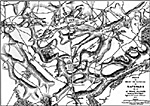
The Orders of 18 June
Napoleon spent the night at the farm du Caillou. He was not sure that he would fight the next day. Wellington could withdraw during the night and take position somewhere beyond the Forest of Soignes. The Emperor dictated an order of battle which has unfortunately been lost to historians.
Large Waterloo Map (slow download: 137K) or Jumbo Waterloo Map (very slow: 484K)
He was informed that two Cuirassiers platoons had skirmished at Tilly with some Prussian cavalry (part of Colonel von Sohr's command) and had followed von Sohr's brigade up to
Mont St.Guibert during its withdrawal toward Wavre. Napoleon had an early supper and went to bed. During that time, the Army of the North deployed.
Napoleon got up early around 1 a.m. It was still raining heavily. He went to reconnoiter the enemy position with General Bertrand and then returned to his Headquarters. Around dawn at 4 a.m., he went out once more to observe Wellington's position, this time with Soult. He dictated to Bertrand these instructions:
"The Emperor orders the army to be ready to attack at 9 a.m. The Corps commanders shall assemble their troops, and allow their soldiers to prepare their soup. They'll allow the soldiers to feed themselves, so at exactly 9 a.m., everyone will be ready to do battle, with their artillery and ambulances, at the position assigned to them last night."
It appears that after issuing these orders, Napoleon went back to bed. He had not much else to do while the army was deploying. Then at 8 a.m., he had breakfast with Soult, Bassano, Ney,
Drouot, Bertrand, Jerome, etc. An animated discussion went on. Jerome mentioned that a party of Prussians had been sighted by a farm boy on the Mont St.Jean plateau:
"Silly thing!" answered Napoleon, "The Prussian army has been defeated; it cannot rally before two days. I shall attack the British army and I shall defeat it." In leaving the table, he further added: "Gentlemen, if my orders are well executed, tonight we'll sleep in Brussels."
It was 9 a.m. and the army should have been ready to march. Yet only the troops that had been there the day before were in position. The rest of the troops were not yet in position. It was no longer raining, the sun was shining and a strong wind was somewhat drying out the
drenched ground.
The deployment continued. Napoleon reviewed the troops as they formed. The bulk of the deployment was accomplished by 11 a.m. So, the stage was set and the attack could have started
immediately. He did not need to attack with the troops that were to be on his second line.
Why did Napoleon, who thought the army could be ready to attack at 9 a.m., delay the attack until 1 p.m.? Why were precious hours once more lost?
Final Order
At 11 a.m, the Emperor dictated his final order to Soult:
"As soon as the entire army will be deployed, at about 1 p.m., at the moment that the Emperor will give the order to Marshal Ney, the attack will begin to capture the village of Mont-St. Jean, at the intersection of the roads. For that purpose, the 12-pdr batteries of the II and VI Corps will be deployed with that of the I Corps. These 24 guns shall fire on the
troops at Mont-St.Jean, and the Count d'Erlon will begin the attack with his left Division and supporting it with the other Divisions of the I Corps. The II Corps shall advance to keep alignment with Count d'Erlon. The sapper companies of the I Corps shall be ready to barricade
themselves in Mont-St. Jean."
We have seen above that at 9 a.m Napoleon, despite the farm boy's report, still chose to believe that the Prussians were far away from Waterloo. At about 11 a.m. the Emperor received a dispatch from Grouchy informing him that all his reports confirmed that the Prussians were
retreating toward Brussels and the I and II Prussian Corps were moving toward Corbais and Chaumont.
Diversion
Napoleon did not wait until 1 p.m. to begin the attack. He decided to start with a diversion on Wellington's right at Hougoumont. But Grouchy's dispatch had somewhat disturbed him. Before he gave Ney the order to attack he decided to take a final look at the battlefield. He was looking especially to the north-east. There on the edge of the woods he saw something. A cavalry patrol sent there captured some horsemen from the 2nd Silesian Hussars who confirmed that they were the vanguard of von Bulow's Corps, some 30,000 strong.
By itself this was a disturbing piece of information, and Napoleon did not know that the rest of Blucher's army was following Bulow's Corps.
Napoleon declared to his generals: "This morning we had 90 chances for us, we still have 60 against 40; and if Grouchy repairs the horrible mistake he has made by playing at Gembloux, and moves quickly, the victory will be more decisive because Bulow's Corps will also be destroyed. We must break through the English center before Blucher becomes more dangerous..."
The reality of the situation was quite different from the Waterloo legend that portrays Napoleon being surprised by the arrival of the Prussians on his right flank. In fact, Napoleon accepted fighting the battle on two fronts. He was gambling for all or nothing. At 1:30 p.m., he ordered Ney to begin his attack. We know the rest.
Continued
To 15 June
16 June: The Events of the Second Day
17 June: The Tardy Pursuit of Wellington and Blücher
Conclusion and Sources
Back to Empires, Eagles, & Lions Table of Contents #12
Back to Empires, Eagles, & Lions List of Issues
Back to MagWeb Master Magazine List
© Copyright 1995 by The Emperor's Press
[This article appears in MagWeb (Magazine Web) on the Internet World Wide Web.
Other military history articles and gaming articles are available at http://www.magweb.com]